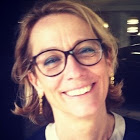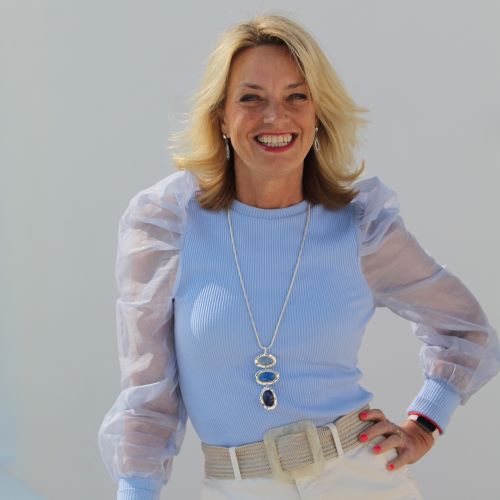Patricia Lannes
Episode 86: Helping Cultural Institutions Find the Way of the Possible, with Patricia Lannes
Art has the power to build bridges between cultures. Our guest in this episode understands that more deeply than most. What if art could even assist in the process of new language learning?
On this episode, we explore the way of the possible with guest Patricia Lannes. Patricia has over 30 years of experience in the cultural field, especially in museum education and visual literacy. She envisions, curates, and produces transformational learning experiences from museum, art, and education professionals, and for audiences of all ages and backgrounds.
As an education and museum consultant, her latest work concentrates on creating frameworks that use pedagogical practices that support equity, cultural participation, and civic engagement in museums. She is the founder and director of CALTA21, an initiative that creates a museum, formal education, and community-based organization partnerships, and builds their institutional capacities to strengthen the academic, social, and cultural capital of immigrant language learners.
She is the former director of education at the Nassau County Museum of Art in Roslyn, New York. Patricia develops training programs for museums on cultural competencies, visual literacy, empathy and dialogue-based strategies. She addresses issues of cultural participation and representation, intercultural dialogue, user-centered programming, Latino, immigrant, and refugee audiences, and identities, art, and language in institutional partnerships in local, regional, national, and international conferences.
She holds a degree in history, from the University of Uruguay, and is immediate past chair of the Latino network, AAM. Through her work with CALTA21, she was nominated to be recognized at the White House as a Champion of Change, an award for Americans with innovative ideas, who are making a difference in their communities.
More on Patricia’s Background
Thank you so much for joining me, Patricia.
You’re very welcome. Thank you, Nicole, for inviting me.
I’m looking forward to your perspective. I know you’ll have such different perspective from our traditional guests on the show, especially regarding creativity and collaboration. But before we dive in, I find it so helpful to have our guests tell their story in their own words.
I’d be glad to. I came to the US as an immigrant and as an English language learner. So, when I moved to the US, I enrolled in English language classes. From then on, I realized that a language was being taught through text and that images were rarely used. Having a strong art history background, and being a museum addict, I’m passionate about looking at art and talking about art.
I thought there was a missed opportunity for museums to use images and the museum spaces where you can move around. It’s very liberating to be in a museum. But they were not being used to develop language. So, that’s how I developed CALTA21. I was answering the question, “What can we do in museums to enhance the image experience and the language experience?”
My personal story influenced what I do. I started not as a museum educator. I thought I was going to be doing research, and I was going to be more in the curatorial area. I also had my children, and I wondered how to take children to museums so that they have fun with it. It’s the idea of making museums accessible to every audience. So, that, on top of the idea of using images for developing language, is what has informed my whole museum life.
I love how you describe yourself as a museum addict. That’s really fun. I’ve got to say; you’re the first self-described museum addict guest that we’ve had on the show.
I know, but I am. Before I was a museum professional, I would just go and enjoy the museum, and learn at the museum. But now, it’s not only enjoying and learning, but I’m also always seeing exhibitions, museum layouts, programs – as a professional. So the addiction becomes a firm, a constant of my life. But it’s an enjoyable thing. It’s not a bad addiction; it’s a good one, I think.
How to Stand Out in the Crowd
Right. And that’s just it. Who says that what you do for work shouldn’t be also something that you enjoy? I love how you took your personal experience in coming to the US, need to learn the English language, and you took your passion, your personal experience, and now have created this organization that helps others learn the language in a new way. I’m interested in learning more about what you do. Just reading your bio, I knew that we were going to learn a lot about creativity and a lot about collaboration in our conversation.
So, to start us off, thinking about creativity, can you talk a little bit about how your organization assists museums with creativity, standing out as an opportunity with these new audiences, and the work that you do?
I work with all sorts of museums as a consultant, but mainly with art museums. Art is all about creativity, and it’s about the use of imagination. As Maxine Green, a philosopher and a philosopher-in-residence for Lincoln Center Institute in New York, and Columbia professor would say, “The release of the imagination allows you to think of the world of the possible.” And if you think about creativity, it’s not about finding a solution. It’s more about looking at what might be issues, or problems, or challenges that have not been addressed. And I think that’s what creativity’s all about. It’s looking at things in a new way.
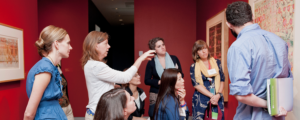
Photo Taken By: Michael Palma
[bctt tweet=”If you think about creativity, it’s not about finding a solution. It’s more about looking at what might be issues, or problems, or challenges that have not been addressed.” – @plannes1 #podcast”]
With CALTA21, we have three main constituents that participate. One is the museum field and museum professionals. Next are the organizations that already work with an immigrant audience, or with an English language learner audience, or with a refugee audience. And the third one is the audience itself. The students, or the participants in those organizations. The way creativity is used is by allowing the participants to see themselves in a new light, look at themselves in a creative way, in the way of the possible. What’s possible? What does that look like?
People need to realize that, to be an immigrant, and to be a refugee, takes a lot of courage. There are a lot of assets people bring to the society that they are adopting as their new home. So, when we developed CALTA, it was about tapping into all those assets, and getting people to think of themselves in a new and creative way. We have developed a whole curriculum that it’s all about identity, portraiture, and photography. And, more than anything, it is about telling your story. Where do you come from? How do you see yourself today in this new home? And what do you expect of yourself in the future?
Students have to write; they have to tell their stories. It’s all very open-ended, so they can choose what story to tell. I’m not going to ask you to share a traumatic experience if you don’t want to share it. It’s up to them to decide what they’re going to share. But then, it’s all told visually through their photographs. So, they take photographs of themselves. They bring old photograph if they have them. Many times, they don’t have an old photograph, because they are refugees, or they left in a situation where they couldn’t bring photographs.
It’s all done in a fresh way of seeing yourself inserted in the new society. So, that’s one of the aspects of creativity for CALTA that makes a big impact on the learner. The other aspect of creativity is to get museum people, museum staff, mainly museum educators to look at the artwork in new ways. How do you break language barriers with images? How can you teach to look and to develop language when you’re looking at an image? What strategies do you use? How do you do it so that it’s engaging, fun, non-threatening? And then, also, for the English language teachers – our third audience – the creative challenge is to help them understand that museums are an amazing resource. Many times, people who have not studied art feel threatened by art and say, “Oh, I cannot teach about art. I cannot use images. Or, I use images in a very simple way.” So, the goal is to get them comfortable in using images and art as a tool for language learning.
Absolutely. I think those were fantastic examples. I love that you opened us up with that quote from the philosopher-in-residence, you said at Lincoln Center?
Lincoln Center Institute, yes. Maxine Green.
The release of imagination allows you to think of the world of the possible. And then, helping us connect that to the experience of an immigrant. And I agree with you that, immigrants or refugees do have a lot of courage to be able to pick up and move their life. What you’re doing with CALTA21 is a great example of creativity, because you’re thinking about how to teach a language, and how to reach these new audiences differently. Not in a traditional way.
I love how you broke it down into your three target audiences that you’re working with, and what it means to them. That was a fabulous path to take us down.
I’m wondering, as you talked about using images to help communicate, what that does to the visiting public, not just to the immigrants and the public that you’re serving with your program. I’m wondering if you’ve given any thought to that or have seen how that translates to the international tourist who might be visiting these institutions.
It’s interesting, Nicole because I didn’t start working with immigrant audiences or language learners. I started working with a regular visitor; a visitor that comes into the museum. I thought one of the main challenges in perception about the museum experience is that people feel like they will get a lecture. You know, you tell me about the painting, you tell me about the artist. And it’s all very concentrated on content that the presenter has learned. But, I think the empowering thing is when you engage with your audience, and it becomes a conversation focused and anchored on the artwork.
Regarding an international focus, I was invited and hired by the Picasso museum, and museums in South America, to do exactly that. Because this is not about English. This is about using the artwork as an excuse for a conversation. And then, we have to develop language. And I’ve been working with many organizations and universities in Europe where they teach Dutch. It’s not about English, but it is about, more than anything, getting comfortable looking at art, and enjoying it. A byproduct of that is learning all the language. I’m working with a friend and colleague on expanding the scope of CALTA, using all the methodologies for cultural tourism. Specifically, we are focused on looking at artwork and engaging in conversations and changing the perspective that we have about museums. I like the term “user” rather than “visitor.” I think that it should be more about the museum user. Libraries have users, and that can change the dynamic. Museums would become another anchor in the community.
I became passionate about museums on my first trip to Europe from South America. My parents took my sister and me on a very long trip – two and a half months. We visited every single museum you can think of where we traveled. I was captivated by the enjoyment and the love of it. That was the beginning of thinking about being on a museum staff, not just a visitor.
After that trip, I understood museums, so I became very comfortable. Now in my current role, the whole idea for me is to transform museums into spaces that are so much a part of the community that they are the community. This requires a real shift. Instead of designing programs for you, it is bringing you into the conversation before we develop the programs so that we understand what you want, desire, and need. This is what we did with CALTA21 at the very beginning. We brought in teachers, we brought in students, and we asked, “What is it that you really want?” And then we developed it.
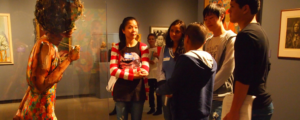
[bctt tweet=”“The whole idea for me is to transform museums into spaces that are so much a part of the community that they are the community.” – @plannes1 #podcast”]
There are so many golden nuggets of information that you just shared with us, and I want to try to capture some of those. I have some other questions I’d like to dive into. But I’m struck as you’re talking. I recently attended the Museum Association of New York’s annual conference, and we have a special podcast series that is coming out as a result of some conversations I had while I was there.
This whole idea of community anchor was a big theme throughout the conference, but also throughout the conversations that I had. I like how you are talking about using the museum as a conversation starter. As a way to be more inclusive, to be the community anchor, as you described. I was also struck when you talked about thinking about a museum visit as a user, and how, by just changing your language, it changes your whole perspective and exactly what it is that you’re doing or who you’re serving.
It’s interesting that many times, people say, “Oh, admissions are very expensive,” so that people don’t come to the museum. Or, other countries don’t charge admission for cultural experiences, or they are all somehow sponsored by the government. How do you change that perception? Oh, I use the cinema, but the museum is something different. It’s a challenge for museums. It’s not a challenge for the public. The public is there. I always say this, and I’ve said it a thousand times: if I’m sitting down at my desk, I’m not doing my work. Because I need to be in the community. We are the community. It’s not that we are for the community. We are the community.
Then we are just one more stop in our daily activities, or our weekend activities, or our night activity. And then, programming is developed according to our understanding of the community. And that’s why many times programs fail in museums. “Oh, they don’t come. They don’t like it.” Well, you did a program, and you didn’t understand what I want. The first time I had a program in Spanish, and it was about a Botero exhibition, and I thought I had done everything. I translated the labels and created a family guide in Spanish. We put some advertisements in a Latino newspaper here in New York.
Then, I’m interviewed at the local TV, and they say, “So, how are they going to open that door and come in?” And I’m thinking, “Well, I did the labels and everything.” And it wasn’t enough. Because you need to train people, also, to understand what you offer, and to feel comfortable with what you offer. And that’s where collaborations and partnerships come into the conversation. That’s when you have to partner with people, with organizations that have a partnership with the library that already is a very strong anchor in the community. Or you have to partner with the schools, which most museums do, but how do you make it so that it becomes something sustainable and not just a one-day thing? I don’t know if I answered your question.
How a Museum Can Be a Community Anchor
Absolutely. No, this is terrific, Patricia. Thank you very much for sharing. I’m wondering if you can give some specific examples of where you’ve seen museums living this new way, this collaborative way of being that community anchor. Maybe in your travels, or in the work that you’ve done, are there any specific examples that you can share that will help our listeners think about how this might apply for them?
Well, there are many. The latest example is the Tucson Museum of Art in Arizona, where they are doing extremely strategic work. My work is all about training institutions, and people in institutions, to work in new ways so that they are inclusive of all, not only of new audiences but of the community. And they become a center. A center of dialogue, or a center where people would go because they feel very comfortable.
The Tucson museum is interesting because they are partnering with so many different organizations. They have access to different segments of their community. And also, they are revisiting their museum practice. Many times, there’s a gap between the curatorial department and the exhibition – the people who prepare the exhibitions, and the education department who works with the audiences. And I’m quoting here … “We are translating what’s on the walls for the public.”
Arizona has many connections with Mexico, and with immigrants. It’s a refugee settlement, and there are multiple Native American people groups. So, the question becomes, How do we respect the voice of the people we are showing the work here?
So, it’s a very prolonged approach. It’s seeing from education, from curatorial, from what’s hanging on the wall, what kind of practice do you have when the visitor comes, how do you go out into the community? When I go there, I don’t only train the museums and the teachers. We have people from community organizations. Then, we had meetings with other cultural organizations. So, the effort is like a coalition. It becomes not just an isolated entity. It’s not an esoteric thing there, up on the hill, and we go and open the door.
That is a great example, and I like how you framed that, that it’s like a coalition. Which means basically that it doesn’t end.
Exactly. If you become stale and you repeat, repeat, repeat the same thing, you are doomed to make errors. One of the characteristics of the 21st Century is that change is permanent. It’s something that is constant. So, you can’t just stay with what you design. You have to be constantly listening. Listening is a very important thing. How do you conduct listening sessions? Are you aware so that you start building trust with all the organizations? And nobody sees each other as competition, which is what many times happens.
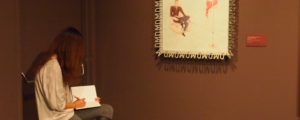
[bctt tweet=”If you become stale and you repeat, repeat, repeat the same thing, you are doomed to make errors.” – @plannes1 #podcast”]
Successful Coopetition Partnership
Well, two things from what you just said, which was this whole idea of conducting these listening sessions, but secondary to that, you mentioned not viewing other institutions as competition. Because, you are sharing that same audience, the folks that might come to the Tucson Museum of Art might tomorrow go to the ballet, or maybe to a historical society, or a Native American museum.
This is something I call “coopeition.” Where perceived competitors come together and cooperate for something that’s for the greater good, and I’m wondering if you have other examples of where that idea of coopetition has worked.
Let me think. You know, it’s interesting. I see it in small scale. Like, a museum partnering with another type of art form organization. Or, with a school district. But, I don’t see that too often on a large scale.
I was consulting a year or two ago with an organization in New York called Cool Culture. We created what’s called Lab for New Audiences. This was the second iteration of that lab, and I was hired to run it. We invited people from museums all over the city. So, we had about 23 museums represented. And the idea was exactly that. Let’s collaborate. And it was amazing, the result in some cases. Like, all the children’s museums collaborating, and training each other, and finding ways of collaborating, instead of, oh, this is my niche, I’m in Brooklyn, and these are my kids, the visitors, the families. So, in that sense, that was a very good example of coopetition. Groups were formed of museums centered on historic homes. They were representatives of many different historic homes across New York City.
It was about creating programs that are relevant. How do we transform historic houses so that they become something that people want to come to? And as I said, become users and not just, oh, today I went once, and that was enough. There’s no reason for me to come back.
That is a good example.
It was a good example, yes. It was about museums. So, though it was all different types of museums. It was children’s museums. We had children’s museums, historic houses, we have art museums, we had parks.
That’s great.
It was a way of learning from each other and building trust. One of the nice outcomes of that was that participants were calling each other and saying, “Can I go and observe you at the Brooklyn Museum and see how you do this so I don’t have to reinvent the wheel?” And that is amazing.
Yeah, that is. That’s a great resource. I want to back up. You just mentioned building trust again, and you talked about that when you were talking about conducting listening sessions. Can we back up and talk a little bit about listening sessions? Do you have any best practices or any advice for our listeners who might be wanting to broaden their reach, or make that connection with the community about how they might go about conducting a listening session? What should they have in mind?
Well, first you have to identify your target audience. You have to decide, “who do I want to listen to so that I learn more?” And then, you have to create critical mass. Not just bring one or two people, because then it’s not representative. Always go to the organizations that already have a constituent base, like the PTA, let’s say. So, that brings you into a larger audience.
And then, it requires a lot of planning. Consider hiring a consultant, or somebody who’s an outsider who will conduct those listening sessions. That way people can feel free to say things that sometimes they won’t say to your face. As a museum, you can conduct them, but it’s also nice when you bring an outsider to conduct some of those sessions.
So then, you put all that information together. And then identify a few of those participants in the listening sessions that can help you co-develop a program, or co-develop an exhibition, or co-develop an outreach program. I don’t like the outreach program idea, because it seems like, I’m going out to you. I’m a lot about equity. How can we all see what we know, and build a shared authority concept to build something together?
So, the listening sessions are very important in anything you are designing. They give you a good understanding of what people want, need, or lack. And you build a sense of trust, but also a space of comfort. People come and feel very comfortable telling you what they want, or what they see that you don’t have, or that you could change. And that doesn’t happen in one time. No, it’s a long process, and it’s not just about vague ideas. Go through the museum, walk the museum, and see, what works for you. What doesn’t work for you? And then, you develop the listening session. You let people understand what you have there, or show them a typical tour. How is it that you do it? And then perhaps conduct the listening session. So that there’s something to answer it in. It’s not just a conversation in the air.
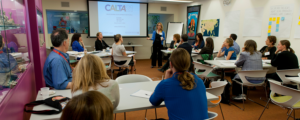
Photo Taken By: Michael Palma
[bctt tweet=”Listening sessions are very important in anything you are designing. They give you a good understanding of what people want, need, or lack. And you build a sense of trust, but also a space of comfort.” – @plannes1 #podcast”]
I just captured a number of great points that you made. To start, it requires planning. So, not just to dive in. And to think about who it is that you want to reach out to. What audience is it that you want this feedback from, I think is important. And then, the whole idea of creating a space of comfort in an area where people will share with you freely, and this idea of using a consultant or a facilitator to help conduct the sessions.
And then, I think, finally, as you wrapped it up was, having something to anchor the conversation in, which really just brings us back to kind of what the theme of our conversation has been, which is this whole idea of using museums as an anchor for a conversation, and wanting to understand in terms of these listening sessions, what is that anchor for that particular conversation?
Exactly.
That’s really important.
No, that’s the beauty. For me as a consultant, I love it when I go into a museum, or into a community. You start looking at patterns. Often it’s the common things – this is not rocket science. It’s just understanding the power of the organization. And the perceptions and the barriers of the organization that traditional marketing just cannot overcome
And actually, you have to find ways of making people feel very comfortable with your space. Sometimes if you want to bring an audience, an advertisement in the newspaper doesn’t work.
Right.
But, if you, in a very nuanced way, find that this is what they like. They like to do this as a family. So, how can we create a family program that will bring them in?
Right. Well, and again, back to some of our earlier conversation in this interview, which is really understanding your community. Having them part of the conversation, and then creating that programming that meets what they’re looking for. Rather than putting an ad in the paper and creating a program you think is good and hoping that they’ll respond and come. I think this has been just a great conversation, Patricia, and I really appreciate you taking time and sharing all of your experience and all of these new ideas and different ways of thinking and looking at things with us today.
Thanks, Nicole.
Is there anything that you would like to share before we say goodbye? Any final thoughts?
Final thoughts. Well, museums have to take risks. You have to try things. Many times some work, and some don’t work. But, if you’re waiting for them to be perfect, they will never happen. So, take a risk. And start small scale. Train staff. Train staff to feel very, very comfortable with audiences, or with … people that they’re not comfortable with, or they’re not used to working with. Change can happen.
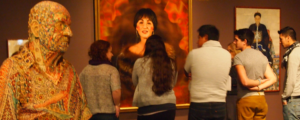
[bctt tweet=”Museums have to take risks. You have to try things. Many times some work, and some don’t work. But, if you’re waiting for them to be perfect, they will never happen. So, take a risk.” – @plannes1 #podcast”]
Those are great final words of advice, and I love that. Take a risk, and start small scale. And know that you will make errors, but you need to do something and take that risk, and then to train your staff, I think those are great parting words, and I appreciate your time today, Patricia, and this has been a great conversation. Thank you very much.
We value your thoughts and feedback and would love to hear from you. Leave us a review on your favorite streaming platform to let us know what you want to hear more of. Here is a quick tutorial on how to leave us a rating and review on iTunes!
